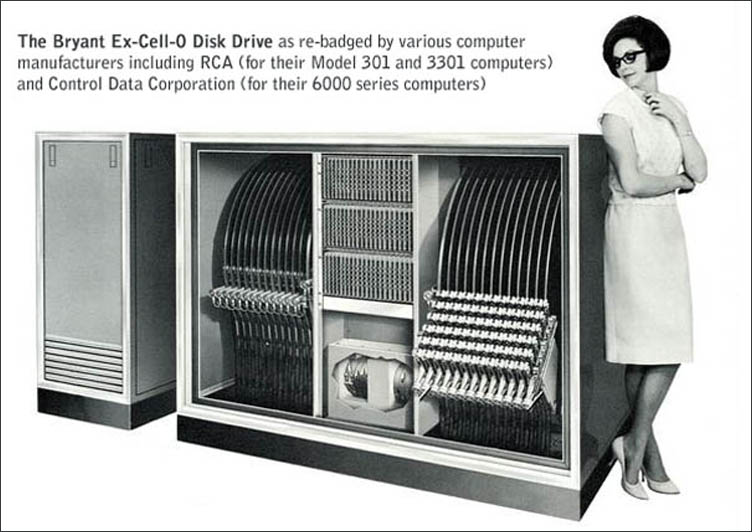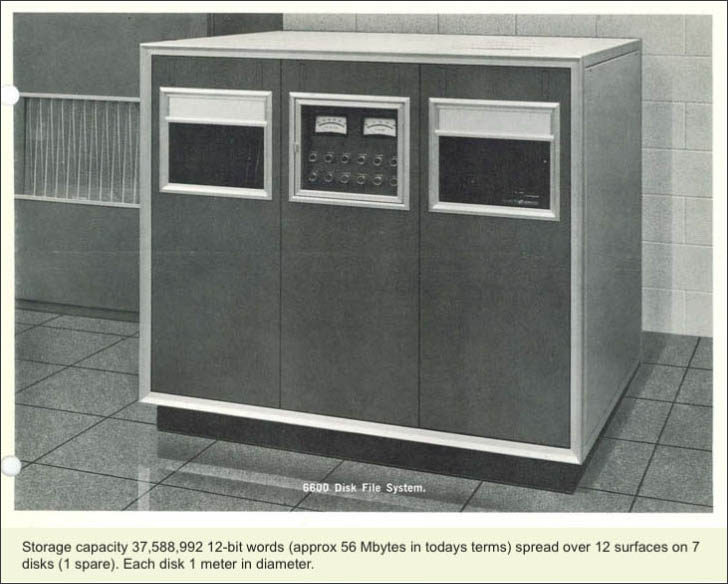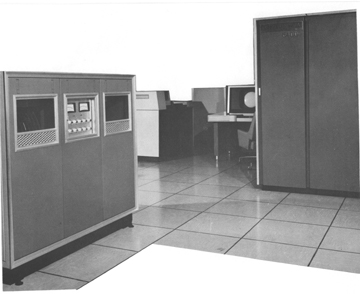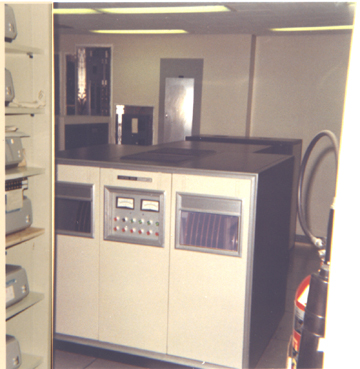The first picture below shows the unit without the front cover so you can see the array of one-meter disks mounted on the horizontal shaft.
The next two pictures below are scanned from early documentation and publicity materials. The last picture shows a unit set in a real working environment - namely Florida State University and was taken in late 1967.




As you can see in the first picture, the disks were mounted on a horizontal shaft, seven platters on one end and seven on the other with the motor drive mechanism in the center. Two banks of 12 disk "surfaces" were actually available for data storage, i.e. each group of 7 platters, one on each end of the main shaft, provided a total of 14 surfaces, but only 12 were for data. One of the other two surfaces was used for a clocking track, and the other was spare.
Speed was achieved by recording in parallel - 12 bits at a time were "striped" across the 12 surfaces. There were four disk heads on each arm, and the one arm per surface was hydraulically operated.
Each surface was organized in a series of four concentric "zones", each zone containing 128 tracks and being swept by one head.
The two outer zones were divided into 128 sectors while the two inner zones only had 100 sectors. (because of less actual available surface at the smaller radius)
Each sector was 351 (decimal) bits long. The programmer thought of a sector (across 12 surfaces) as an area of 351 PP words (of 12 bits), of which 322 were available for data, another 2 words were control bytes, and the rest were not accessible by the PP (presumably used by the hardware)
Taking a 12-bit PP word as worth 2 "bytes", then the storage capacity of one bank works out as:
- Zone 1 has 128 tracks * 128 sectors * 644 bytes = 10,551,296
- Zone 2 has 128 tracks * 128 sectors * 644 bytes = 10,551,296
- Zone 3 has 128 tracks * 100 sectors * 644 bytes = 8,243,200
- Zone 4 has 128 tracks * 100 sectors * 644 bytes = 8,243,200
Note the above numbers are taken from the two references cited below, but in the controller manual, it also states that the total capacity of the unit is 37,355,520 12-bit words, which is slightly different from the calculations above which give 37,588,992 12-bit words. I haven't figured out why, but it is too late now to send a comment in on this document using the postage-paid sheet found on the last page of the manual.
The Bryant-Excello Origins. This disc was actually built by Bryant-Excello and was OEM'd by both RCA (available for use on their 501 and 301 computers) and Control Data (on their 6000 series), The Computer History Museum Archives have a copy of an early brochure from Bryant Excello about this disk which may be seen here. (PDF file) This brochure adds a considerable amount of detail - for example that there were two main choices of capacity (involving 14 or 26 physical platters) and two choices of speed (900 or 1200 RPM).
References:
- Chippewa Operating System Manual, Pub #60134400, Dec. 1965
- Reference Manual for the 6603 Disk File Controller, Pub #60334000, 11/1/70, see here
Return to Home Page